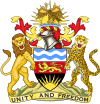Malawi (1964–1966)
It has been suggested that this article be merged into Malawi. (Discuss) Proposed since March 2022. |
Malawi | |||||||||
|---|---|---|---|---|---|---|---|---|---|
| 1964–1966 | |||||||||
| Motto: "Unity and Freedom" | |||||||||
| Anthem: Mulungu Dalitsi Malawi "God Save Malawi" | |||||||||
 | |||||||||
| Capital | Zomba | ||||||||
| Government | Unitary parliamentary constitutional monarchy | ||||||||
| Queen | |||||||||
• 1964–1966 | Queen Elizabeth II | ||||||||
| Governor-General | |||||||||
• 1964–1966 | Sir Glyn Smallwood Jones | ||||||||
| Prime Minister | |||||||||
• 1964–1966 | Hastings Banda | ||||||||
| Historical era | Cold War | ||||||||
• Independence | 6 July 1964 | ||||||||
• Republic | 6 July 1966 | ||||||||
| Currency | Malawian pound | ||||||||
| |||||||||
Malawi was a predecessor to the modern-day Republic of Malawi. It existed between 1964 and 1966.[1][2][3] When British rule ended in 1964, by the Malawi Independence Act 1964,[1] the Nyasaland Protectorate, formerly a constituent of the Federation of Rhodesia and Nyasaland, became an independent sovereign state. The British monarch was head of state and Malawi shared the sovereign, Queen Elizabeth II, with the other Commonwealth realms. The monarch's constitutional roles were mostly delegated to the Governor-General of Malawi, Sir Glyn Smallwood Jones (6 July 1964 – 6 July 1966).[4]
Queen Elizabeth II did not reside in or visit Malawi in the 1960s, but she did visit in 1979 (22–25 July).
Hastings Banda held office as prime minister (and head of government). Following the abolition of the monarchy, the Republic of Malawi came into existence on 6 July 1966 and Banda became the first President of Malawi.
See also[]
- Cabinet Crisis of 1964 in Malawi
References[]
- ^ a b "Malawi Independence Bill (1964)". Parliamentary Debates (Hansard). House of Commons. 11 May 1964. Retrieved 2017-01-26.
- ^ "Malawi Republic Bill Hl (1966)". Parliamentary Debates (Hansard). House of Lords. 14 June 1966. Retrieved 2017-01-26.
- ^ Ben Cahoon. "Malawi". Worldstatesmen.org. Retrieved 2017-01-26.
- ^ Sir Glyn Jones: a Proconsul in Africa", by Colin Baker. Published in 2000 by I.B. Tauris, London and New York (ISBN 978-1-86064-461-0).
- Former Commonwealth realms
- Malawi and the Commonwealth of Nations
- 1960s in Malawi
- Government of Malawi
- History of Malawi
- Politics of Malawi
- Malawi–United Kingdom relations
- 1964 establishments in Malawi
- 1966 disestablishments in Malawi
- 1966 disestablishments in Africa
- 1964 establishments in the British Empire
- 1966 disestablishments in the British Empire
- 20th century in Malawi
- Former countries of the Cold War
- States and territories established in 1964
- States and territories disestablished in 1966
- Malawi stubs


